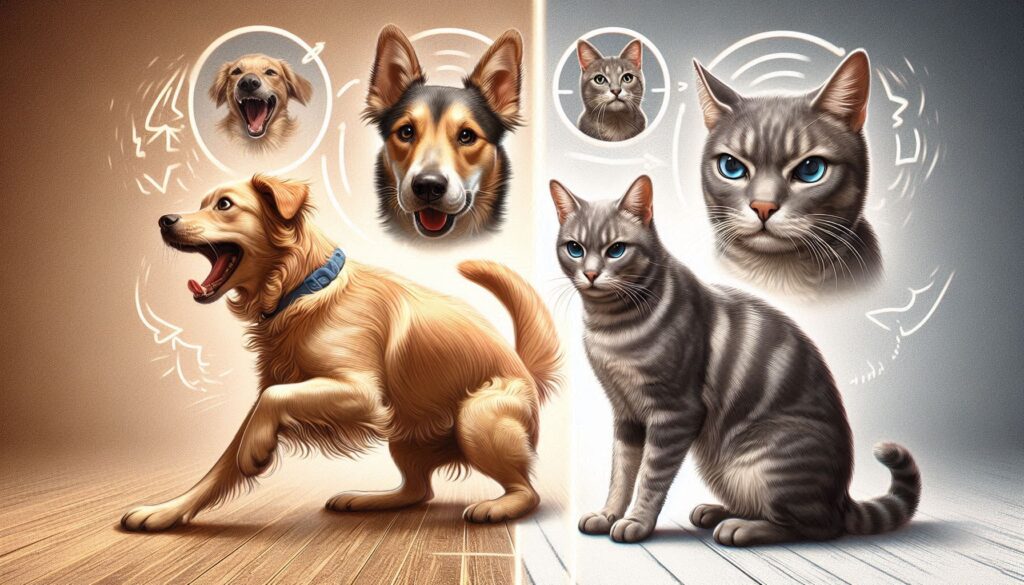
Ever wondered what your dog’s wagging tail really means? Or why your cat suddenly flicks its tail before pouncing? Pets communicate with us all the time—not through words, but through body language. Learning to read these signals helps strengthen your bond with your furry friend and ensures their well-being.
Understanding Dog Body Language
Dogs express their emotions through their tail, ears, eyes, and posture. Here’s how to decode their signals:
Tail Language:
- Wagging Tail (Fast & Loose): Happy, excited, and friendly!
- Wagging Tail (Slow & Stiff): Unsure or alert—assess the situation.
- Tucked Tail: Fear, anxiety, or submission.
- Raised Tail (Still): Confident or dominant stance.
Ear Positions:
- Ears Forward: Curious, alert, or interested.
- Ears Back & Relaxed: Submissive or showing affection.
- Ears Pinned Back: Fearful, anxious, or feeling threatened.
Eye Contact & Facial Expressions:
- Soft Eyes & Relaxed Face: Comfortable and content.
- Whale Eye (Showing Whites of Eyes): Nervous, anxious, or uncomfortable.
- Direct Stare (Stiff Body): Can signal dominance or aggression—proceed with caution.
Body Posture:
- Relaxed Stance: A happy and calm dog.
- Play Bow (Front Down, Back Up): An invitation to play!
- Stiff, Upright Posture: Can indicate dominance or an impending reaction.
- Rolling Over & Showing Belly: Submission or trust—belly rubs, please!
Understanding Cat Body Language
Cats may seem more mysterious, but they’re constantly communicating with us. Here’s how to decode their signals:
Tail Language:
- Slowly Swishing Tail: Focused or contemplating action.
- Fast Flicking Tail: Annoyed or agitated—give space!
- Puffed-Up Tail: Feeling scared or threatened.
- Tail Wrapped Around You: A sign of affection and trust.
Ear Positions:
- Ears Forward: Curious or playful.
- Ears Turned Sideways: Uncertain or mildly annoyed.
- Ears Flattened Back: Angry, scared, or defensive—proceed with caution!
Eye Contact & Facial Expressions:
- Slow Blinking: “I love you” in cat language—return the slow blink!
- Dilated Pupils (Big Eyes): Excited, scared, or ready to pounce.
- Narrow Pupils: Focused or possibly irritated.
Body Posture:
- Arched Back (With Fur Raised): Defensive, feeling threatened.
- Exposed Belly (But Watch the Claws!): Can mean trust, but not necessarily an invitation for belly rubs.
- Kneading with Paws: Comfort and affection—often a sign of happiness.
Common Misinterpretations & How to Respond
Misconception: A wagging tail always means a happy dog.
Truth: Context matters! A stiff, slow wag can mean uncertainty or caution.
Misconception: A cat purring always means they’re happy.
Truth: While purring usually signals contentment, some cats purr when in pain or stressed as a self-soothing mechanism.
Misconception: A dog showing its belly always wants a rub.
Truth: It can be a sign of submission rather than an invitation—check other body signals first.
Misconception: A cat flicking its tail is playing.
Truth: A flicking tail often means irritation. If your cat starts swishing its tail rapidly, they may be getting agitated.
Strengthening Your Bond Through Body Language
Now that you can read your pet’s signals, use this knowledge to build a stronger connection!
- Respect their signals—if your cat flattens its ears, give them space.
- Engage in positive reinforcement—reward relaxed, happy body language with treats or affection.
- Match their energy—if your dog offers a play bow, engage in playtime!
Final Thoughts
Learning your pet’s body language creates a deeper bond and helps prevent misunderstandings. By paying attention to their cues, you can ensure a happier, stress-free life for your furry companion.
Does your pet have unique body language quirks? Share them in the comments below! 🐾